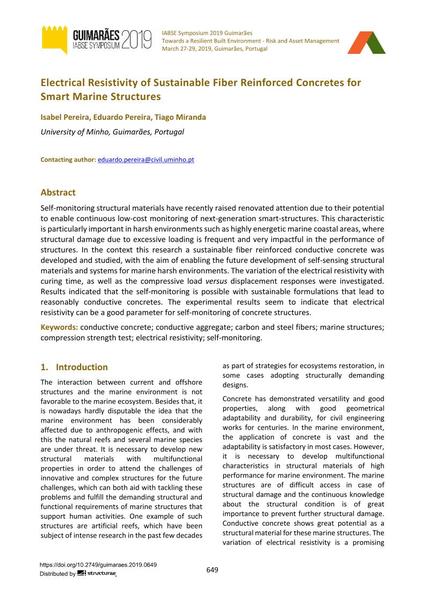Electrical Resistivity of Sustainable Fiber Reinforced Concretes for Smart Marine Structures

|
|
|||||||||||
Bibliographic Details
| Author(s): |
Isabel Pereira
(University of Minho, Guimarães, Portugal)
Eduardo B. Pereira (University of Minho, Guimarães, Portugal) Tiago Miranda (University of Minho, Guimarães, Portugal) |
||||
|---|---|---|---|---|---|
| Medium: | conference paper | ||||
| Language(s): | English | ||||
| Conference: | IABSE Symposium: Towards a Resilient Built Environment Risk and Asset Management, Guimarães, Portugal, 27-29 March 2019 | ||||
| Published in: | IABSE Symposium Guimarães 2019 | ||||
|
|||||
| Page(s): | 649-656 | ||||
| Total no. of pages: | 8 | ||||
| DOI: | 10.2749/guimaraes.2019.0649 | ||||
| Abstract: |
Self-monitoring structural materials have recently raised renovated attention due to their potential to enable continuous low-cost monitoring of next-generation smart-structures. This characteristic is particularly important in harsh environments such as highly energetic marine coastal areas, where structural damage due to excessive loading is frequent and very impactful in the performance of structures. In the context this research a sustainable fiber reinforced conductive concrete was developed and studied, with the aim of enabling the future development of self-sensing structural materials and systems for marine harsh environments. The variation of the electrical resistivity with curing time, as well as the compressive loadversusdisplacement responses were investigated. Results indicated that the self-monitoring is possible with sustainable formulations that lead to reasonably conductive concretes. The experimental results seem to indicate that electrical resistivity can be a good parameter for self-monitoring of concrete structures. |
||||
| Keywords: |
electrical resistivity conductive concrete conductive aggregate carbon and steel fibers marine structures compression strength test self-monitoring
|
||||
